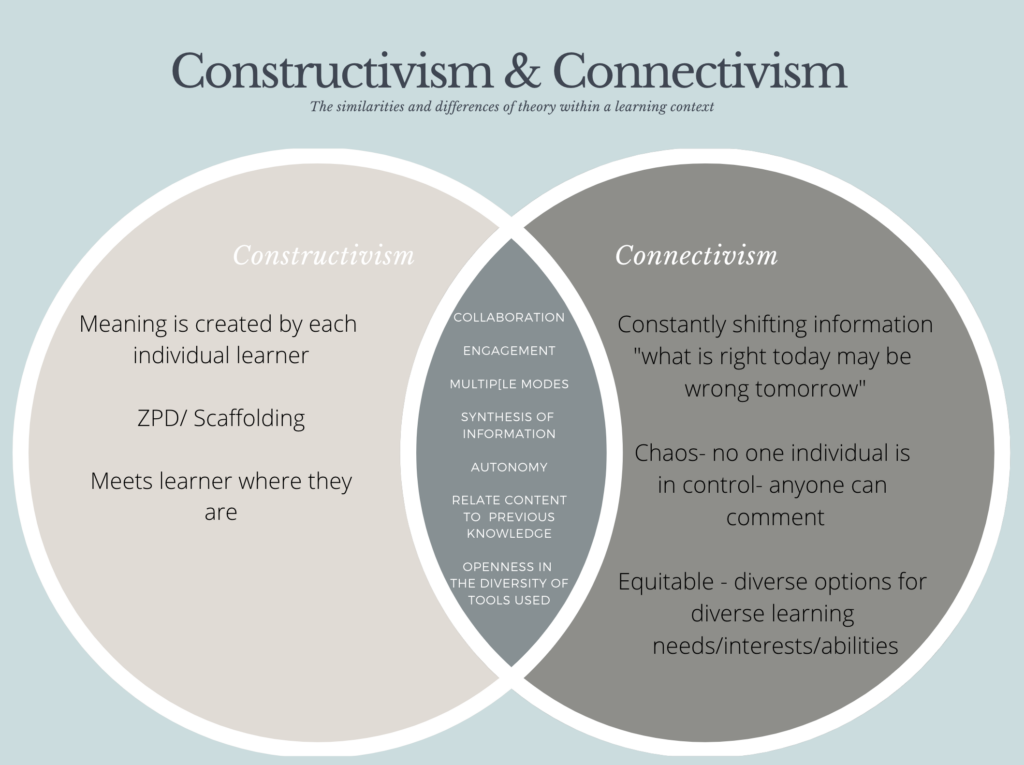*Please note: What you will find (in italics), my added thinking after our second Webinar. I learned more information after the activities and conversations we had and wanted to add it to this post.
Constructivism vs Connectivism
While reading this weeks informational objects, I found it easiest to create a Venn diagram in Canva to show my thinking and to demonstrate my understanding of the materials.

While curating this diagram, I realized quickly that I was having a difficult time pulling out differences and that I was finding mostly similarities. This made me register that these two theories are very similar and that, at times, Connectivism can act as an aid to the Constructivism theory by offering it principles to improve it. For example, Connectivism adds chaos into the mix and can teach a Constructivist that information is constantly changing and that, “while there is a right answer now, it may be wrong tomorrow due to alterations in the information climate affecting the decision” (Weller, 2020). Therefore, a constructivist’s mindset, or ways that they develop their pedagogy, may take a more connectivist approach. This could be as simple as implementing WIKIS to the mix so that learners can see information being developed and curated in real time, thus witness how information is ever changing through collaboration and an open continuous conversation. Those same learners then have the opportunity to add to the conversation as well.
That being said, Connectivism expects the user to have the cognitive abilities and soft skills to be able to problem solve and to understand the privacy concerns related with it. This is a problem when it comes to youth, or people who are not aware of these concerns. Using tools, such as open VR games, withouut thinking of the privacy concerns can put people at risk without even knowing it. Creating a user name, or signing up for an account can offer up pieces of your identity that can be used/sought out by anyone. Another issue comes to light when we see digital natives heading straight into connectivism then being expected to learn in a behaviourism or cognitivism based environment. This poses issues since the digital natives are used to having voice, choice, autonomy and the ability to freely access and share ideas in real time. This contradicts the behaviourist methods and can create a strain on the learner because they are used to other, more flexible and freeing, ways of learning and sharing. This only highlights the importance of shifting our teaching systems to better fit the learner. We need to shift current systems by implementing connectivism into teaching theory so that we can increase connection, engagement and truly meet our learners where they are at: In open learning environments that are increasingly connected and globalized. We must adapt to as our learners have.
Similarities and Differences
When I look at similarities, both theories favour collaboration, having the learner at the centre, using multiple modes, allowing for autonomy and recognizing that learners already bring knowledge and experiential insights to the table. When I look at the differences, the one which presents itself is that Constructivism seems to be more structured around Theorists such as Vygostky, Bruner and Skinner, while Connectivism seems more chaotic and less researched. I did note however, that although both theories allow a learner to learn at their own pace in their own way, Connectivism truly allows the learner to continue that learning journey into their future outside the course which acts as an aid in lifelong learning. The ability to continue learning outside the course, sets the learner up for success in their future because it gives them vital skills to innovate and create within their passions, as well as move forward in the unknown possibilities of their future learning.
EdTech Trend – PLE (Personal Learning Environment)
The“EdTech trend” which interested me the most from Weller’s (2018) article was PLE. This interested me the most because I can see how valuable tapping into several tools and platforms can be. I believe that the more skills and tools that are available for someone to learn/ use, the more they are set up for demonstrating their knowledge in a way that best suits them at the place there are at NOW. This is much like the constructivism theory in a sense that it is learner centred and learner accessible. It also speaks to connectivism since it provides them with multiple platforms and tools, which allows learners to gain several vital skills needed to perform in their futures, thus setting them up for life long learning. I have seen this in my past courses where I have been asked to use specific environments that may not have necessarily been on my radar, or of preference to me. However, those same tools have now been used in my future depending on who I am working with and what best suits our/my own needs. Weller’s article mentions how, ” each learner had his/her own particular blend of tools,” (Weller, 2020) and for me, this is true. However, that being said, I do tap into the plethora of PLE’s which I have learned over the past year in my education courses as well, depending on when I need them. This ability to tap into, and change my personal learning environment based on what I need now, has truly made me become a resilient and adaptive learner. This resilience and adaptability will only prove to enhacce my skills as a learner and individual in my future.
I hope that in the next few weeks I can truly define open learning and e-learning. I am still struggling to divide the two. That being said, perhaps they are much like the Venn Diagram above where there are more similarities than differences. Either way, I hope it becomes clear sooner rather than later.
Citation
Weller, M. (2020). Chapter 17 –Connectivism. 25 Years of Edtech. AU Press. Retrieved from https://read.aupress.ca/read/25-years-of-ed-tech/section/198057f5-1a3e-4436-a4b8-c6e1a3e0bd69#ch17
Weller, M. (2018, August). Twenty Years of Edtech. EDUCAUSE Review, 53(4). Retrieved fromhttps://er.educause.edu/articles/2018/7/twenty-years-of-edtech

